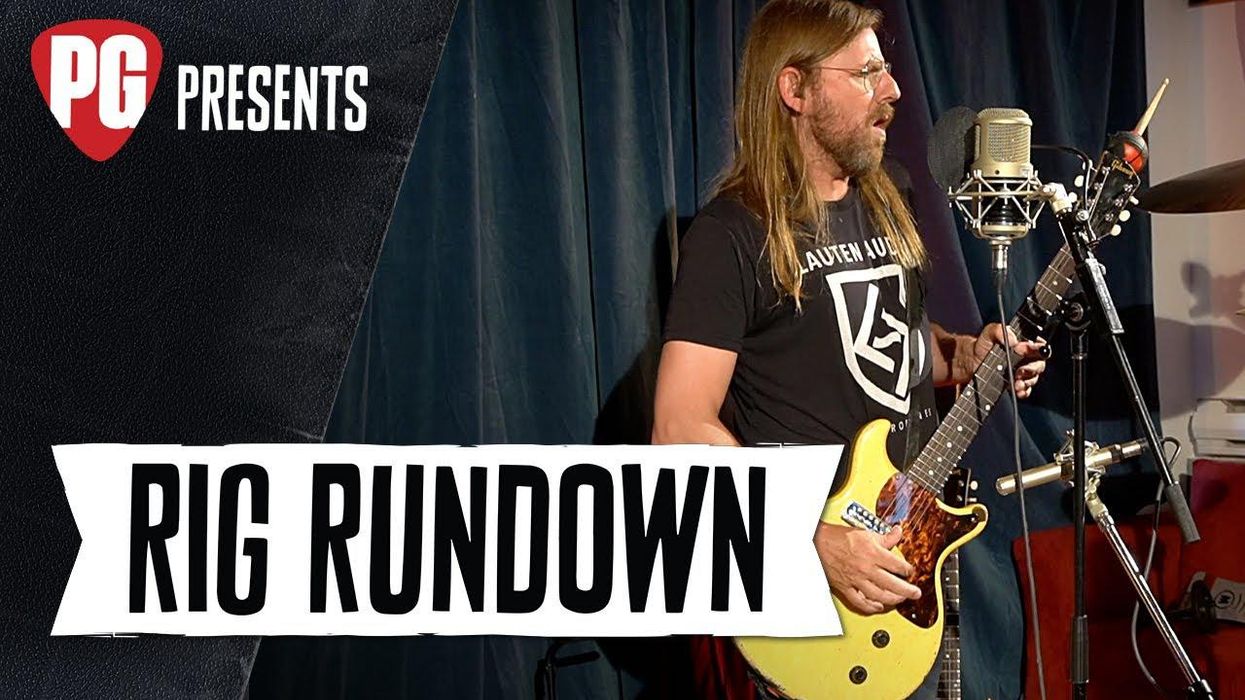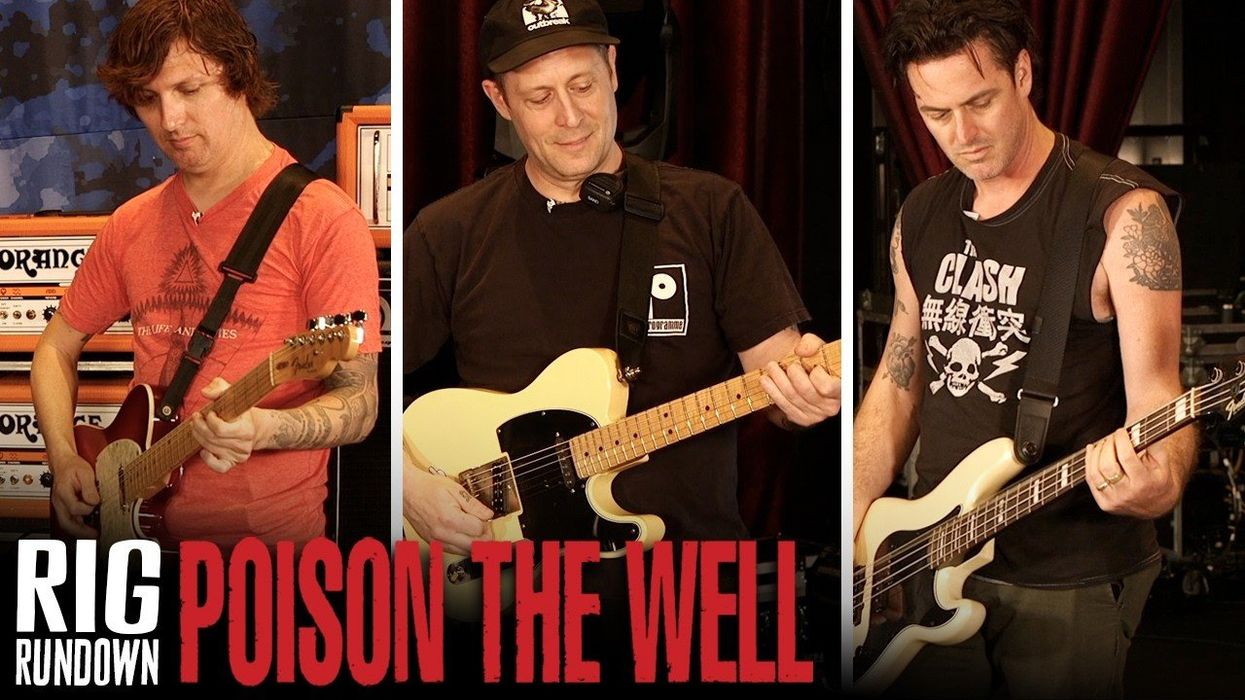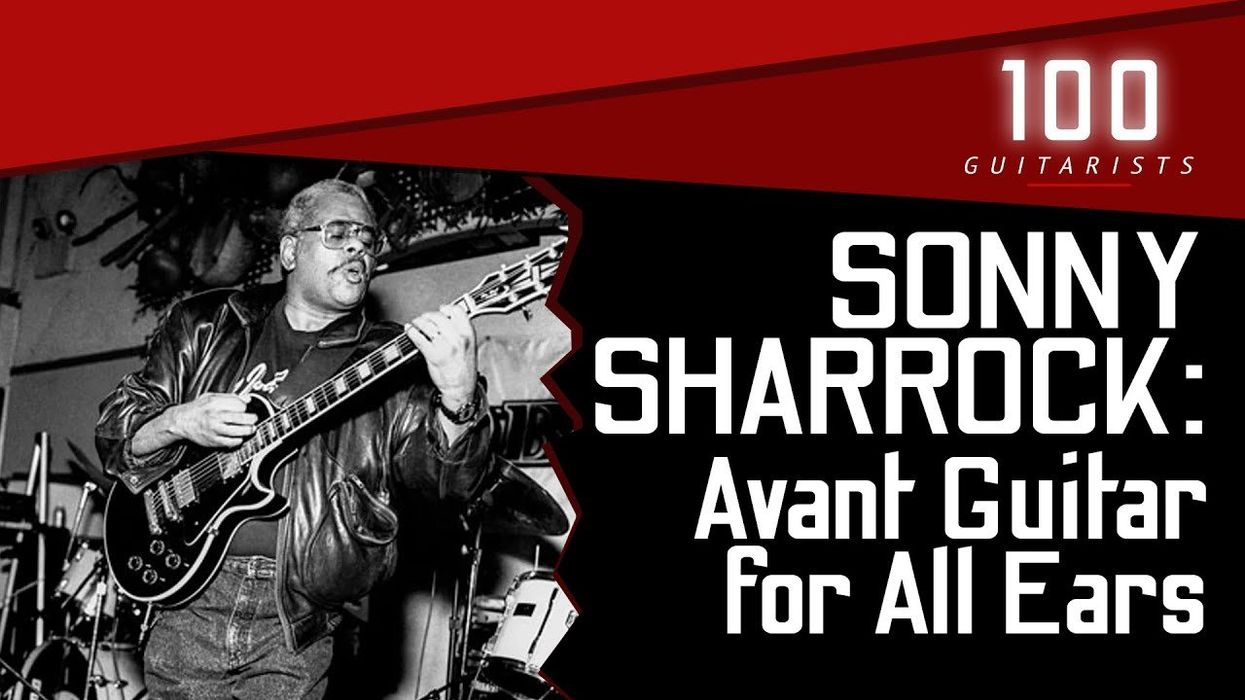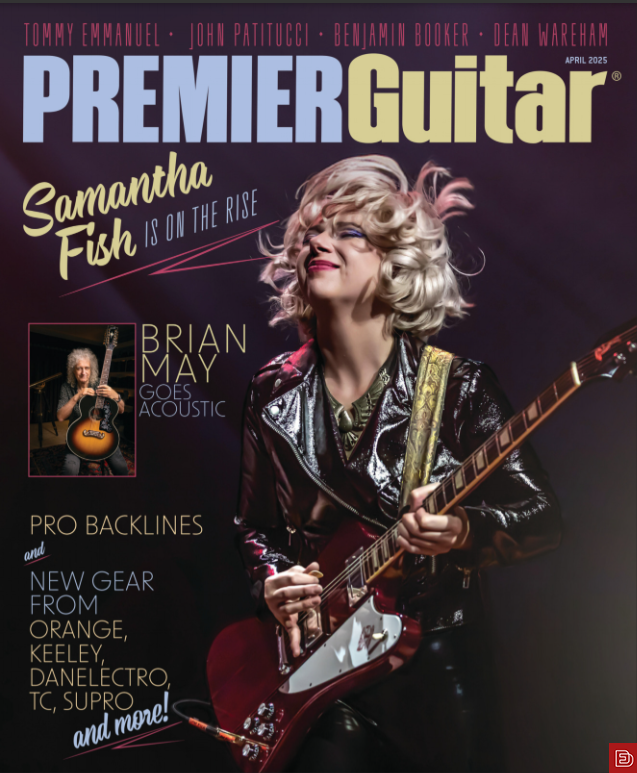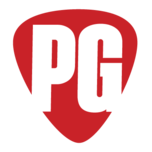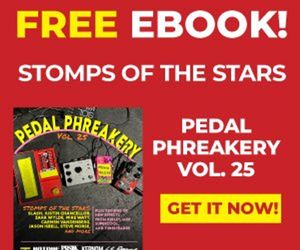The charismatic Canuck demonstrates how to be a one-person power trio with drumstick-equipped vintage Gibsons and a pedalboard that's been sidelined by a kick drum and crash cymbal.
French-Canadian Steve Hill has been a professional musician since the age of 17. Sometimes as a sideman, sometimes as a frontman, but always onstage with a guitar in his hands and a smile on his face. About 10 years ago, Steve Hill released an album, and it was DOA—it bombed and nothing happened with it (his words, not ours).
"I don't know how to do anything else besides music, so I had to make a living and I own a studio so figured I'll do some solo shows and I'll record a solo album to sell at those shows," says Hill.
That album was called Solo Recordings, Vol. 1 and it's his best-selling record to date. It completely changed his career and it really helped him find his artistic voice. Vol. 1 started out very simple—he sang, played guitar, and stomped his feet. About halfway through that record, he added a kick drum. Then he bought a hi-hat that was used on a few of the last songs recorded for Vol. 1. And for every acoustic song he's recorded, he's used a can of coins tapped to his feet as added percussion.
The success of the Vol. 1 led him to record subsequent albums Vol. 2 and Vol. 3. Each of those records incorporated more and more instrumentation falling on the hands, feet, and shoulders of Hill to pull off both onstage and in the studio. But this wasn't his artistic vision.
"It's all accidents—I never planned for this. I never wanted to be a one-man band [laughs]," says Hill. "125+ shows a year provides a great learning environment. Plus, when I'm not performing, I'm in the studio fine-tuning my approach and working out new material. Everything I recorded for those first three albums was performed live with no overdubs. I wouldn't allow it [laughs]!"
And what's the typical reaction he sees onstage: "Some people are mesmerized, and some people are horrified."
In this episode, the multi-tasking Steve Hill virtually invites PG's Chris Kies into his Canada-based recording studio. The Juno-Award-winning guitarist [Blues Album of the Year (2015)] details why he slides vintage Teisco gold-foils on his holy grail Gibsons and Fenders, explains the evolution of his setup that now covers bass and drums, and proves that one man can get the job done of three.
[Brought to you by D'Addario XL Strings: https://www.daddario.com/XLRR]
All Steve Hill's video, audio, and photos captured and edited by Stephan Ritch.
1959 Gibson Les Paul Junior
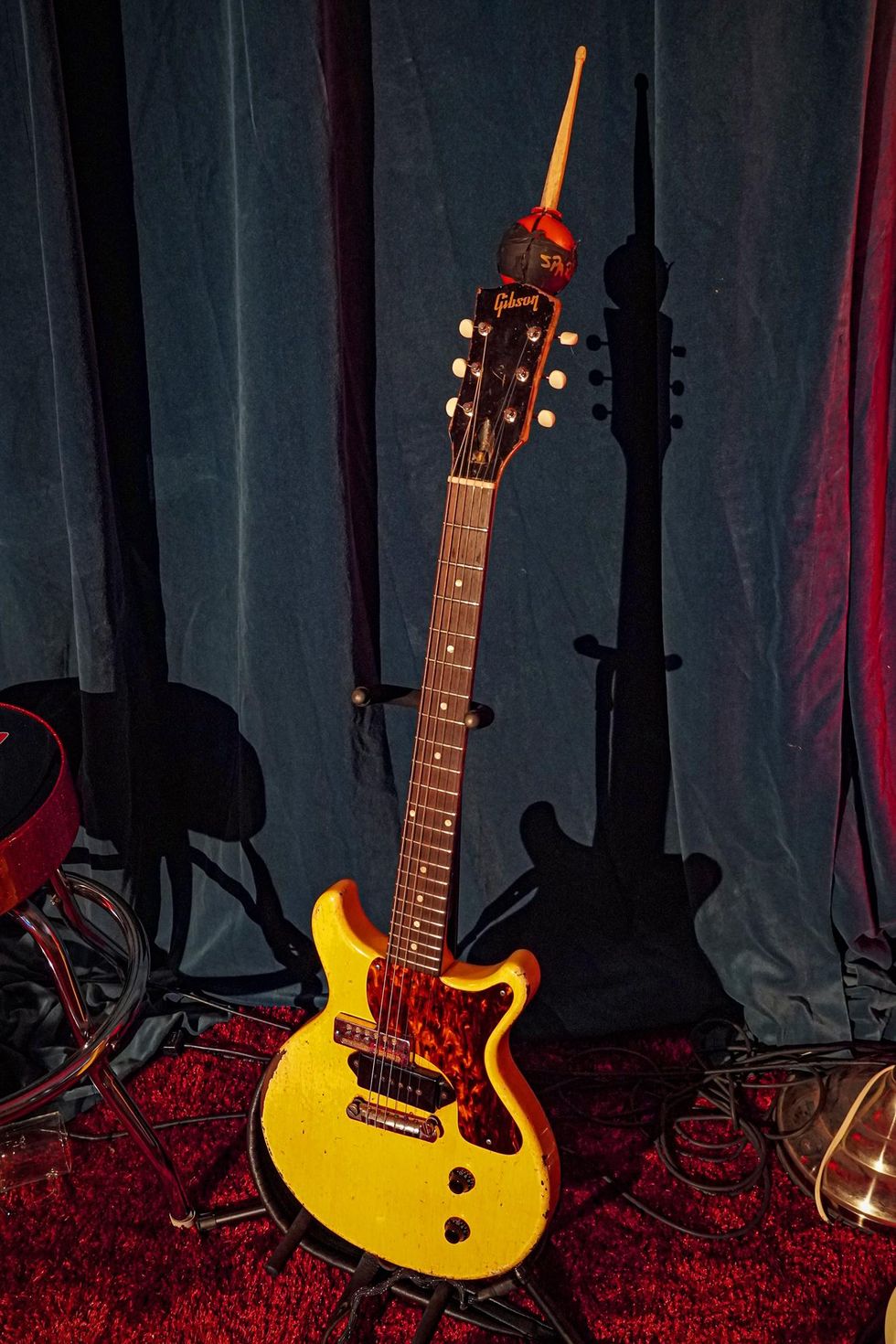
No, your eyes aren't deceiving you, that is a true 1959 Gibson Les Paul Junior that was been jerry-rigged with a Teisco gold-foil pickup. Before you start trolling, realize that the guitar has not been damaged or modded in any irreversible manner. When building his solo sound barrage, he specifically sought out the old gold-foils because they slid under the strings without any routing or surgery. And notice how the gold-foil only sits under the Junior's top three strings. (The only thing he had to do was add a stereo output to the Junior so the Teisco pickup hits a bass amp — a 1966 Ampeg B-15 paired with an EHX POG— while the stock P-90 goes through varied combinations of old Fenders.)
Yes, the neck has been broken (five times), but believe it or not, only one occurred while drumming. ("The final punch of a show in Scotland.")
For his Juniors, Hill typically rides with D'Addario NYXLs (.011–.056) and he hasn't used a pick in nearly 30 years. His tunings include D standard, a tweaked open G (D–G–D–G–B–C), and several of the usual-suspect open tunings. And all his gold-foil guitars take a Vovox stereo cable.Close-Up of Hill's '59 Junior
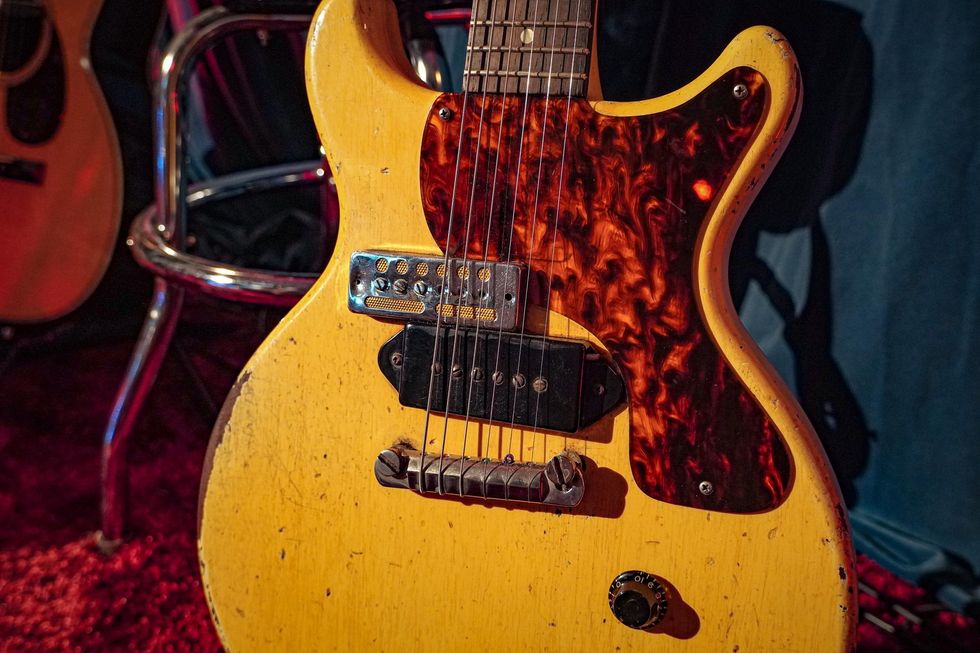
Here's a close-up of the 1959 Gibson Les Paul Junior with its stock P-90 and retrofitted Teisco gold-foil.
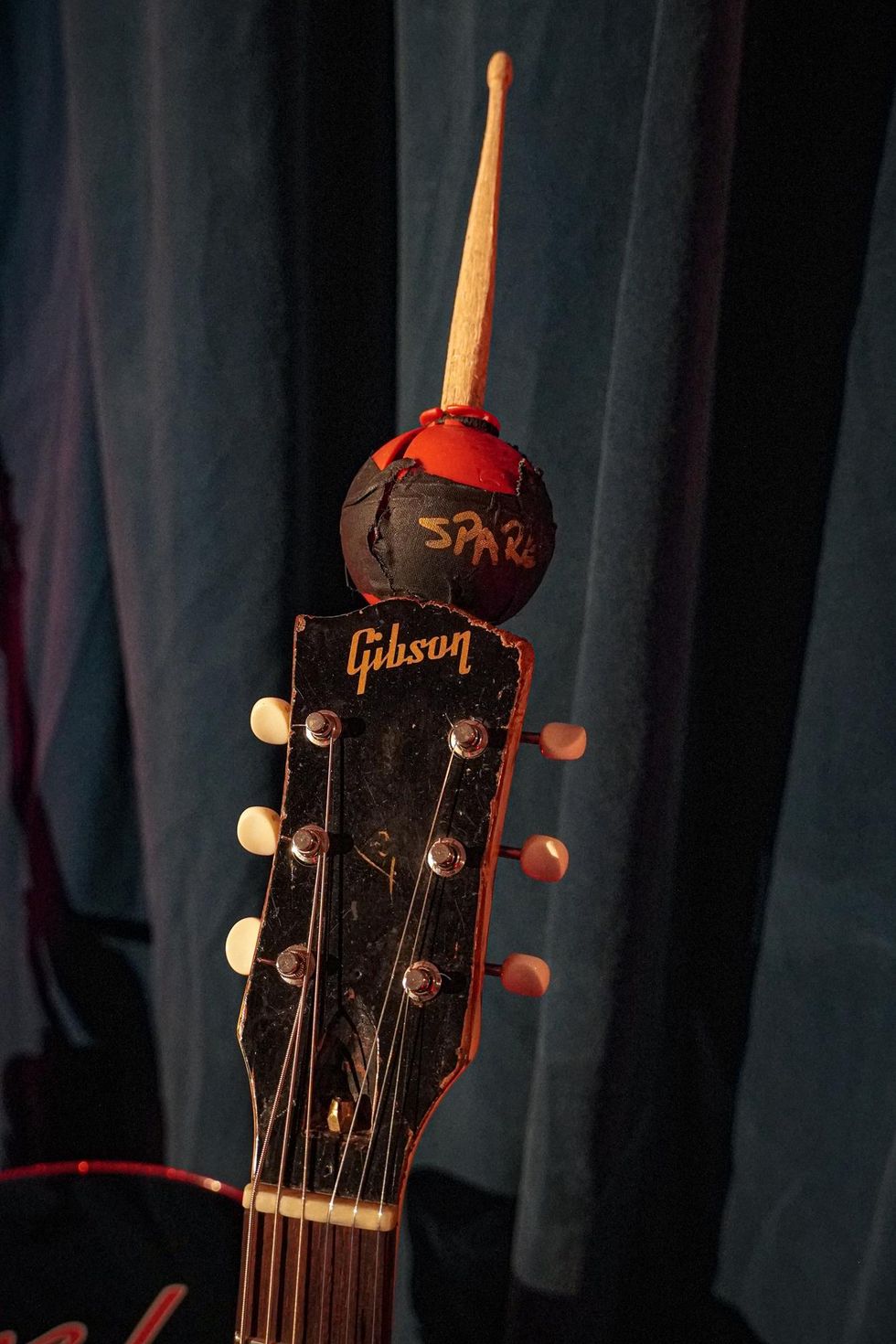
Here's the '59's headstock with a maraca and drumstick.
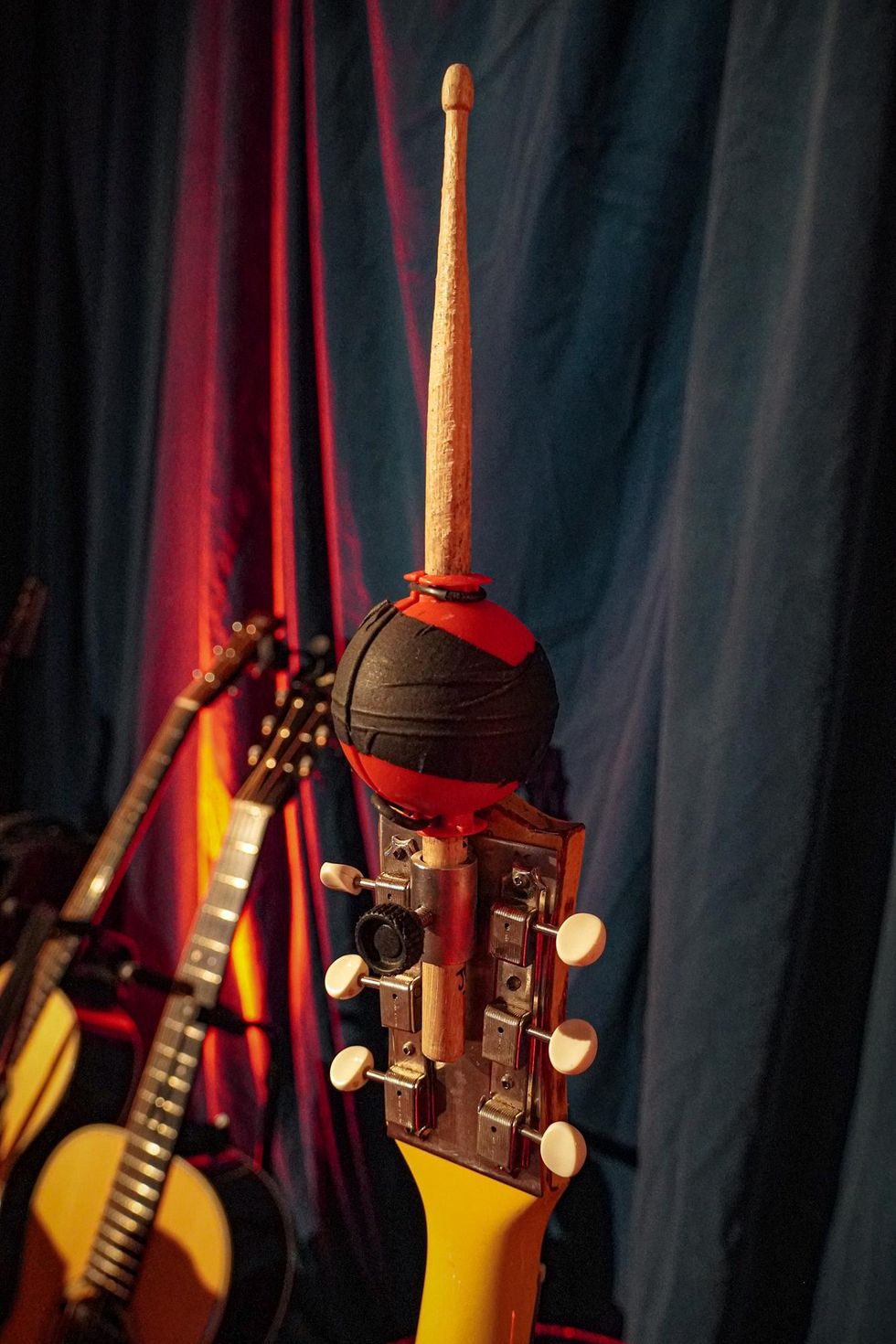
This is how they fasten to the headstock. Again, no major surgery, Hill just removed the tuners and put the metal plate on the headstock before putting back on its tuning pegs.
1956 Gibson ES-225
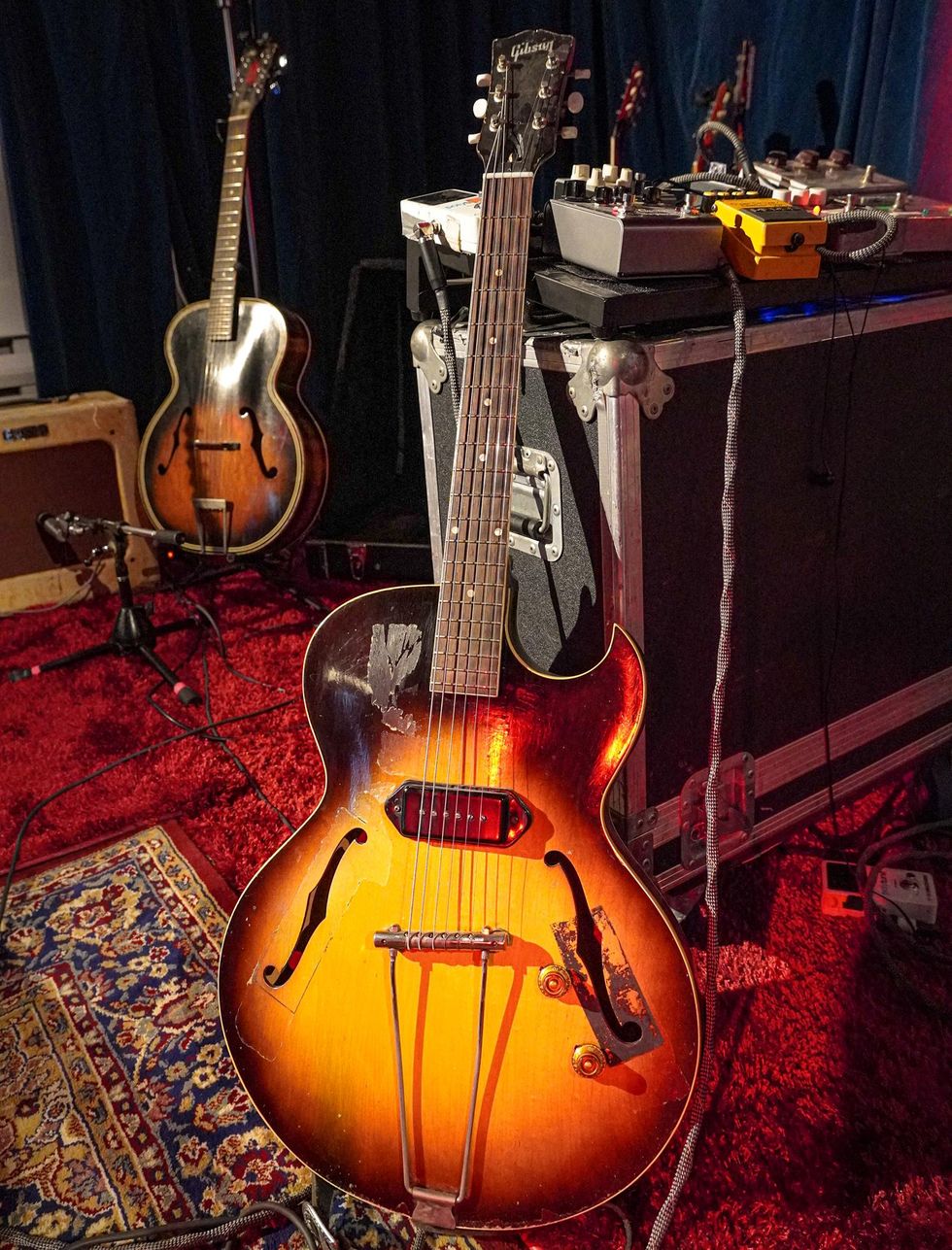
This 1956 Gibson ES-225 is where all this craziness started. He primarily used this guitar to record Vol. 1 and the first to feature the P-90-and-gold-foil recipe. (If you look towards the upper bout, you can see residue from gaffer tape that held the Teisco to its top.)
1962 Fender Jazzmaster
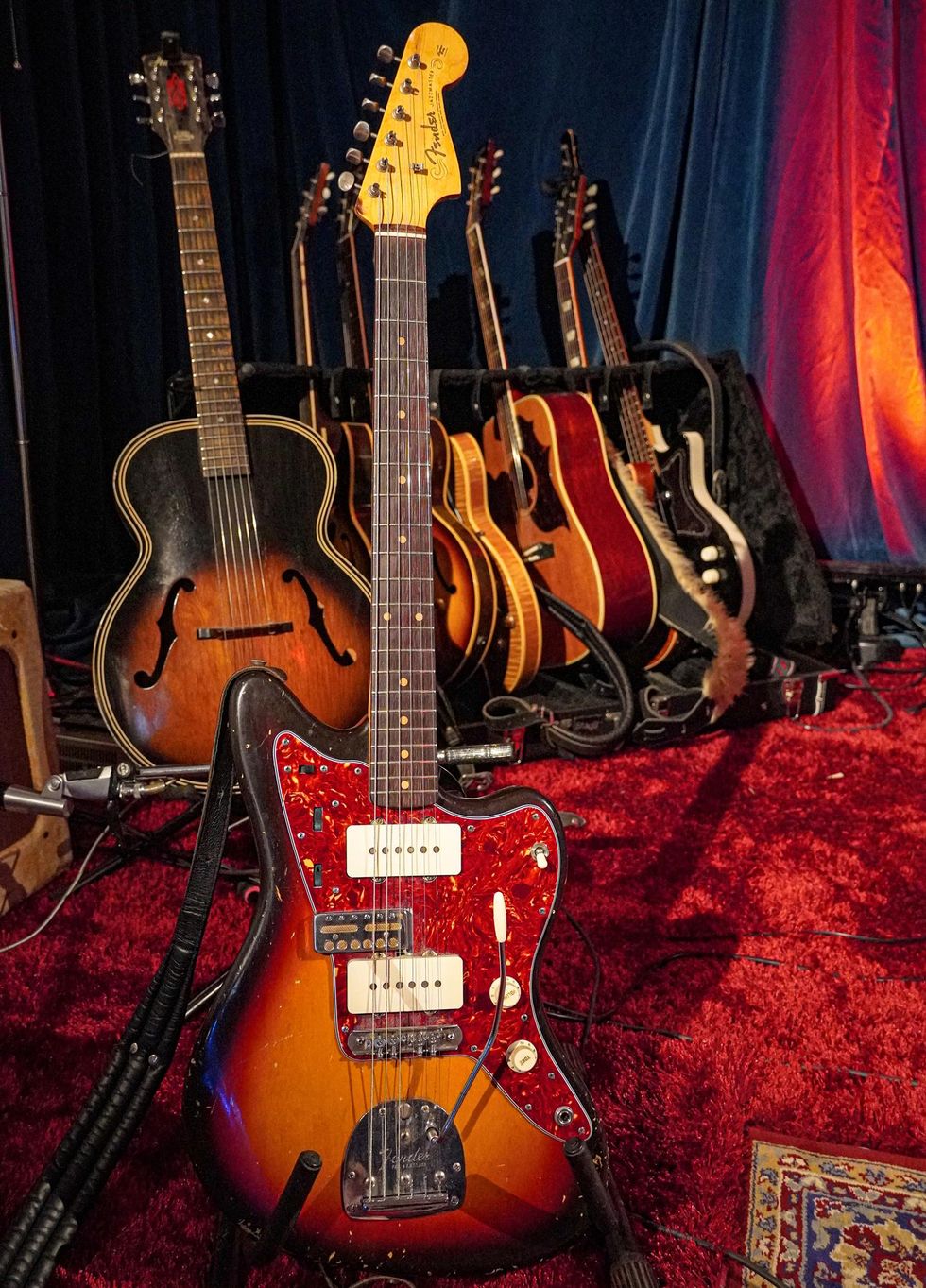
"Over the past year, this guitar has become my favorite," gushes Steve Hill when introducing his 1962 Fender Jazzmaster. "After putting a Mastery bridge on it, I don't think I've played a better guitar than this."
Obviously, we see the gold-foil, but to fit the additional pickup he had to make a custom pickguard. (Rest assured, purists, he still has the original in the guitar's case.)Collings 002H T
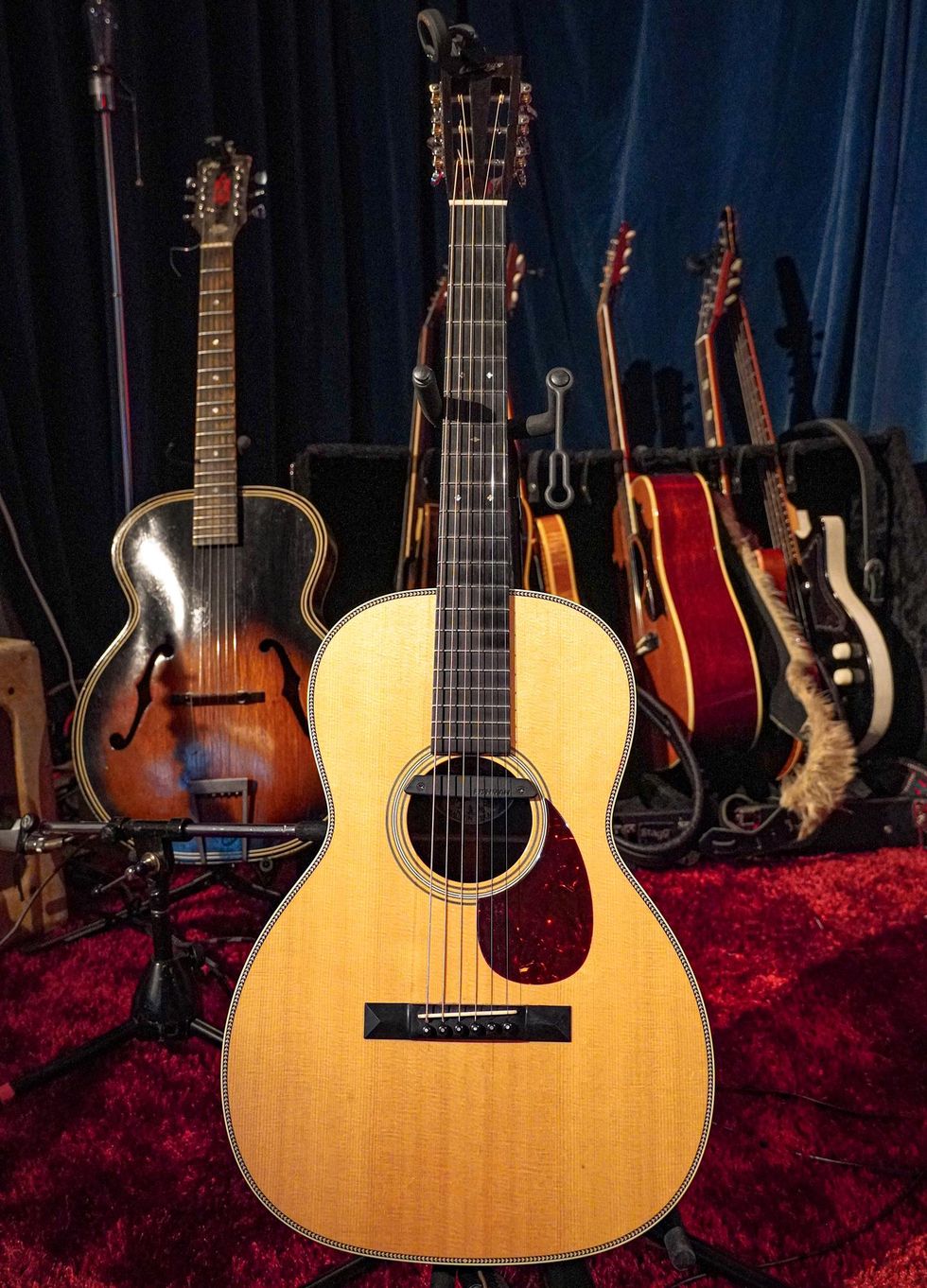
"I've had many acoustic guitars, but this is perfection," says Hill when referring to his Collings 002H T. "I've been playing more acoustic guitar and it's absolutely because of this 00 parlor." Since getting it, he's added the Fishman Rare Earth soundhole pickup.
1964 Gibson SG Junior
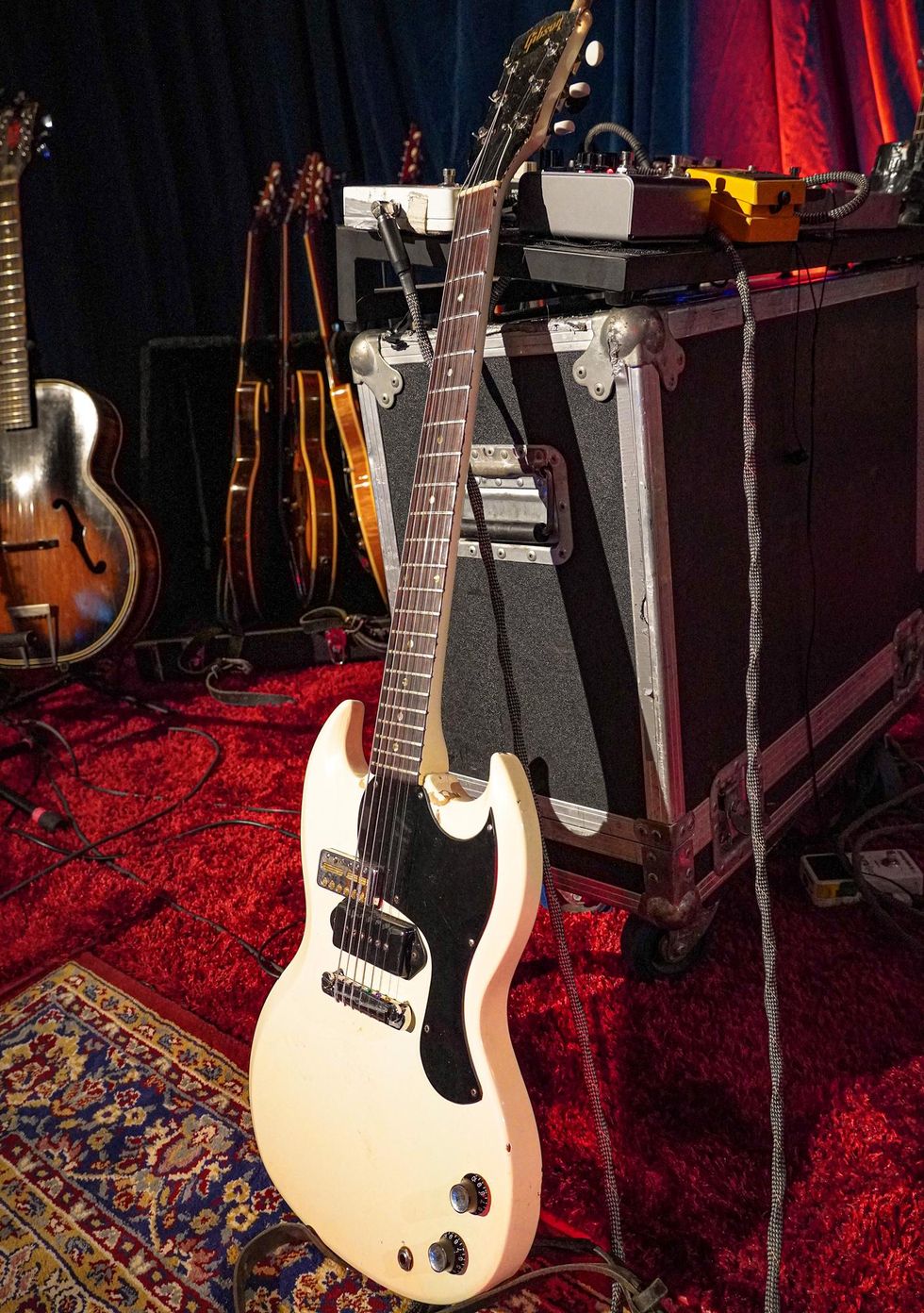
If it's slide time for Steve, he's grabbing this 1964 Gibson SG Junior. Another consideration beyond tone for Hill is the instrument's weight. If it's too heavy, it throws off his headstock-drumming technique. This one is light and rips, so it's a keeper.
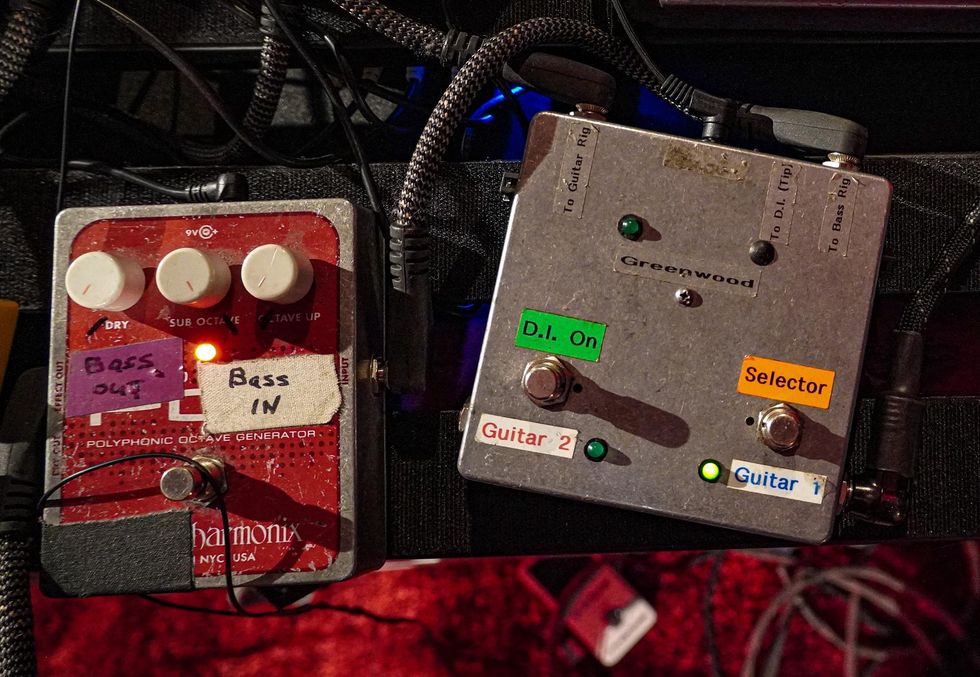
Here is the aforementioned EHX POG that bolsters the bass signal before hitting the 1966 Ampeg B-15. The nondescript box on the right splits the signal coming out of the guitar so he can hit multiple bass and guitar amps.
Steve Hill's Pedalboard
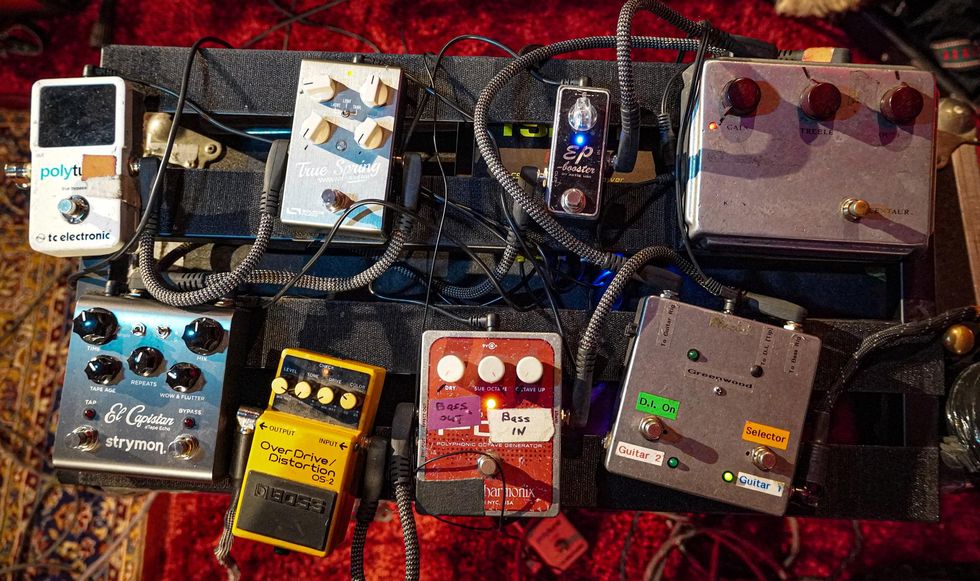
The guitar signal is met with an always-on, three-stage boost blast—Xotic EP Booster, Klon Centaur, and Boss OS-2 OverDrive/Distortion. Hill rides the dynamics with the guitar's volume knob. The EP and Klon are set to neutral settings with only the Klon having the treble and output knobs at noon (while the is gain dialed out). For road work, he opts for a Strymon El Capistan and Source Audio True Spring for delays and reverb. A TC Electronic PolyTune keeps his guitars in check.
Steve Hill's Studio Effects
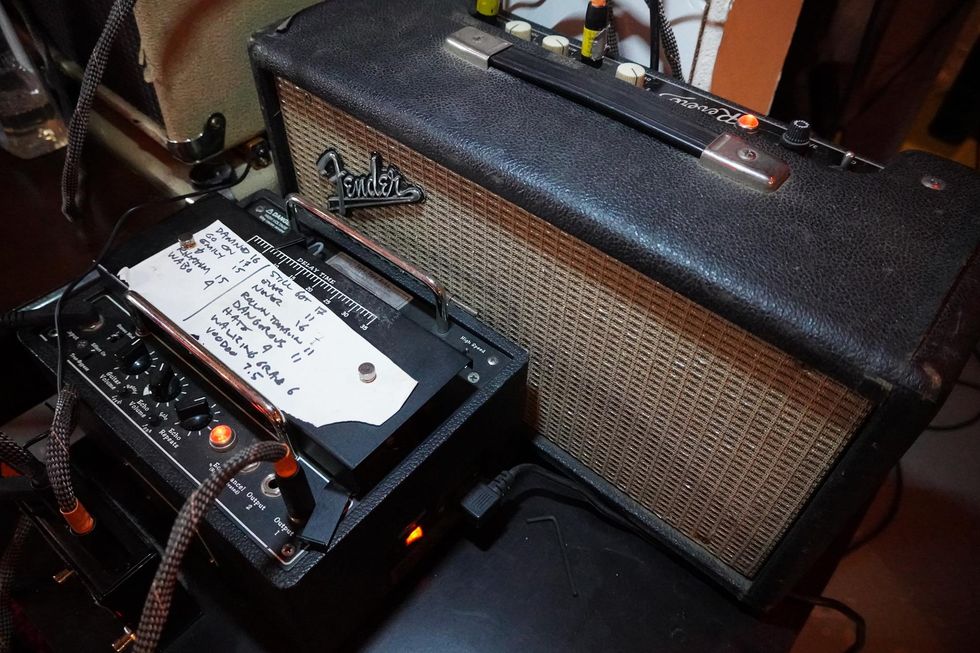
For studio work, Hill trusts his tone to a Fulltone Custom Shop Tube Tape Echo CS-TTE and 1964 Fender Reverb Unit.
1966 Ampeg B-15
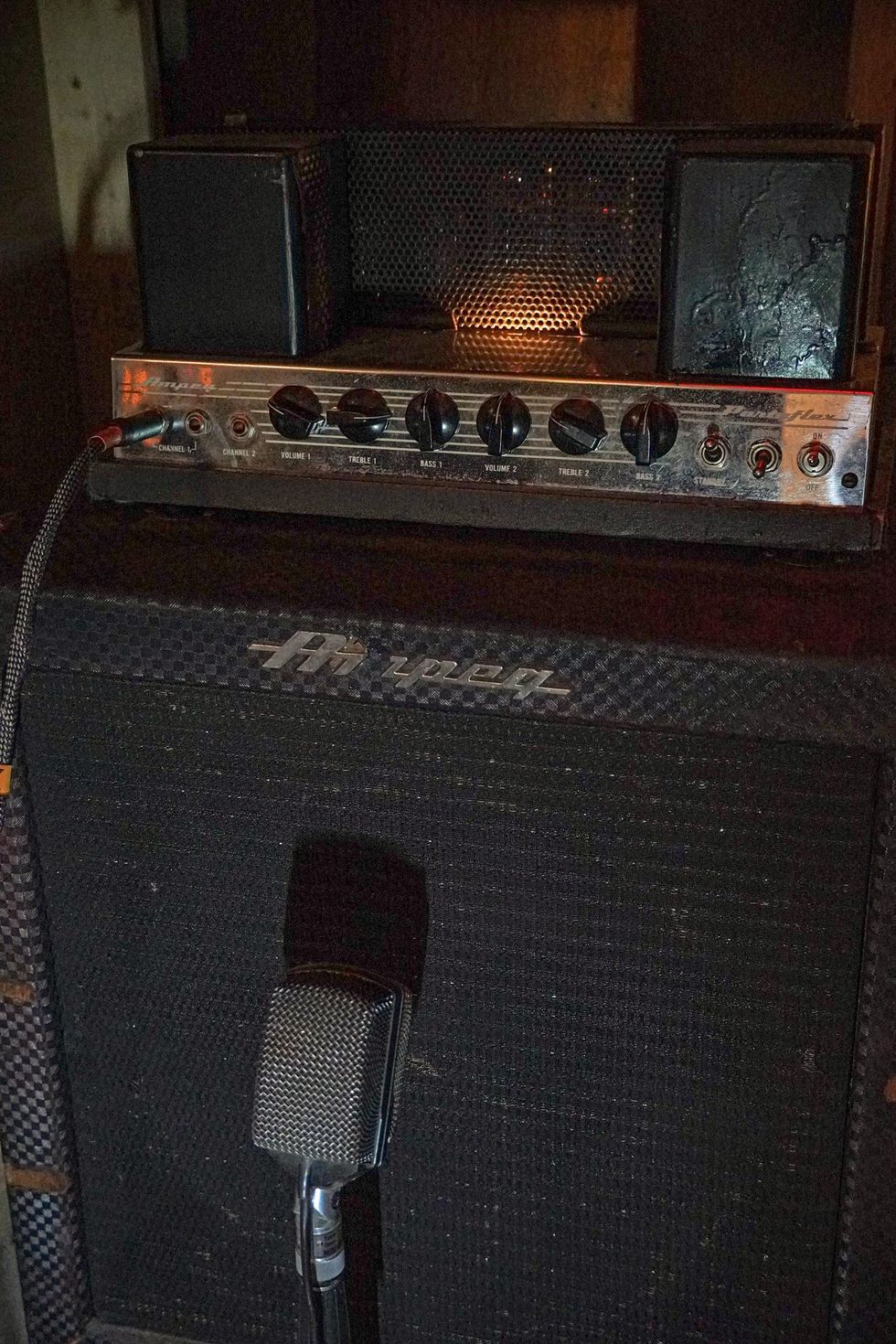
Here is a 1966 Ampeg B-15 used for Steve's "bass" signal.
Hill's Vintage Fender Combos
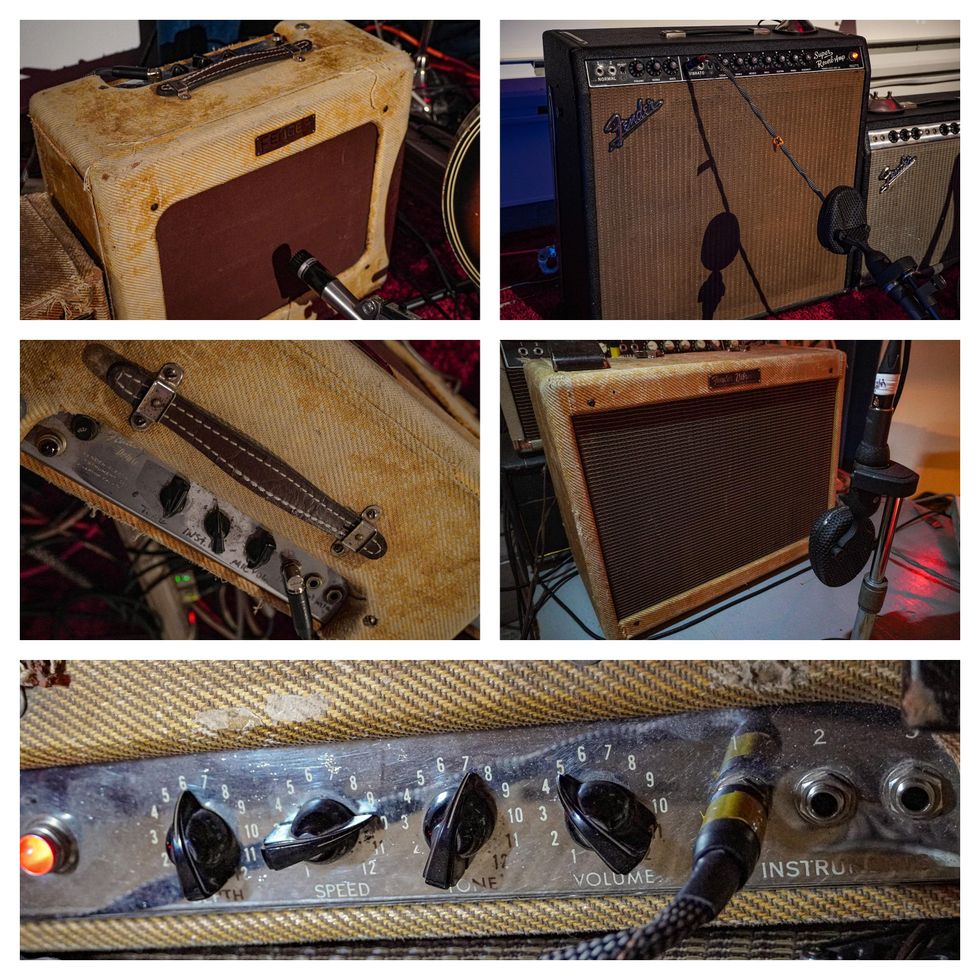
A lot of Steve's tone comes from his jaw-dropping amp collection. For the shoot, we were introduced to a 1950 Fender Deluxe (left photos), a 1964 Fender Super Reverb for acoustics (top right), and a 1956 Fender Vibrolux (bottom right and lowest photo).
- Marcus King's Old Soul - Premier Guitar ›
- Dan Auerbach Summons the Ghosts of Mississippi Blues - Premier ... ›
- Blues Basics: 10 Essential Ways to Get Through the Blues - Premier ... ›
The veteran Florida-born metalcore outfit proves that you don’t need humbuckers to pull off high gain.
Last August, metalcore giants Poison the Well gave the world a gift: They announced they were working on their first studio album in 15 years. They unleashed the first taste, single “Trembling Level,” back in January, and set off on a spring North American tour during which they played their debut record, The Opposite of December… A Season of Separation, in full every night.
PG’s Perry Bean caught up with guitarists Ryan Primack and Vadim Taver, and bassist Noah Harmon, ahead of the band’s show at Nashville’s Brooklyn Bowl for this new Rig Rundown.
Brought to you by D’Addario.Not-So-Quiet As a Mouse
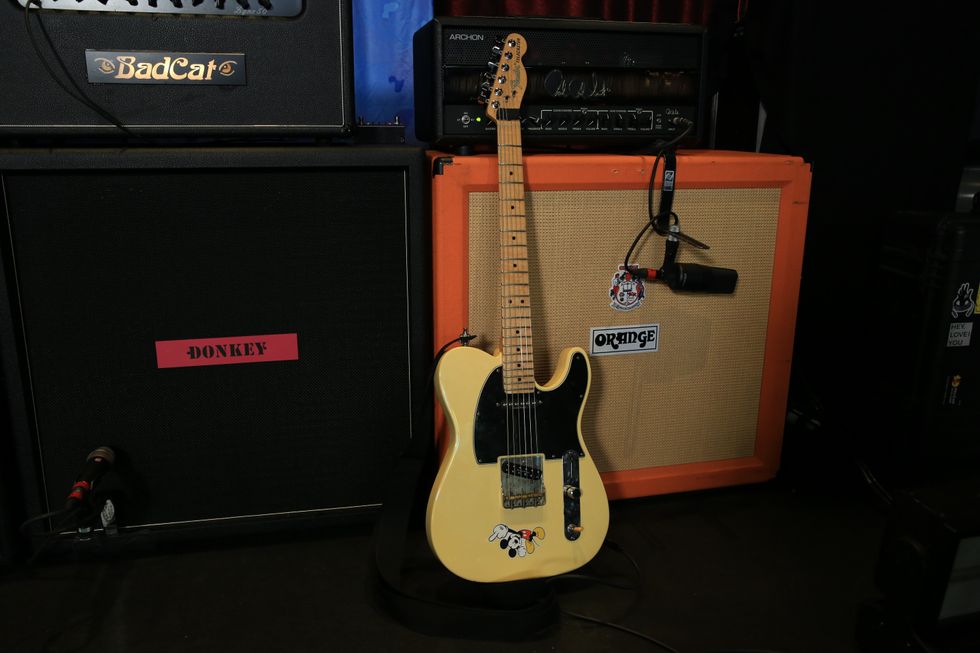
Primack started his playing career on Telecasters, then switched to Les Pauls, but when his prized LPs were stolen, he jumped back to Teles, and now owns nine of them.
His No. 1 is this white one (left). Seymour Duncan made him a JB Model pickup in a single-coil size for the bridge position, while the neck is a Seymour Duncan Quarter Pound Staggered. He ripped out all the electronics, added a Gibson-style toggle switch, flipped the control plate orientation thanks to an obsession with Danny Gatton, and included just one steel knob to control tone. Primack also installed string trees with foam to control extra noise.
This one has Ernie Ball Papa Het’s Hardwired strings, .011–.050.
Here, Kitty, Kitty
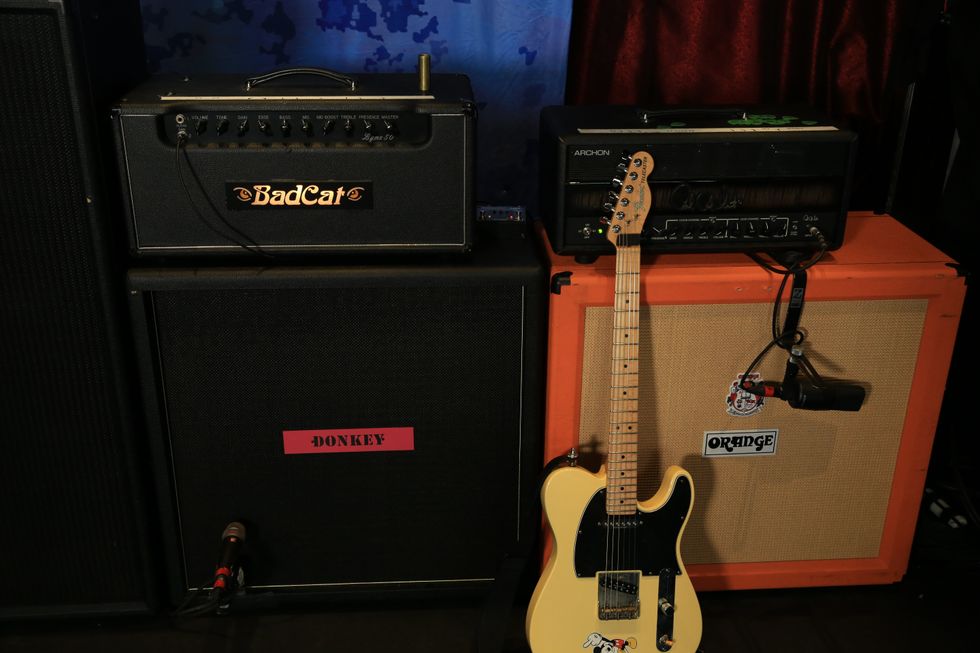
Primack runs both a PRS Archon and a Bad Cat Lynx at the same time, covering both 6L6 and EL34 territories. The Lynx goes into a Friedman 4x12 cab that’s been rebadged in honor of its nickname, “Donkey,” while the Archon, which is like a “refined 5150,” runs through an Orange 4x12.
Ryan Primack’s Pedalboard
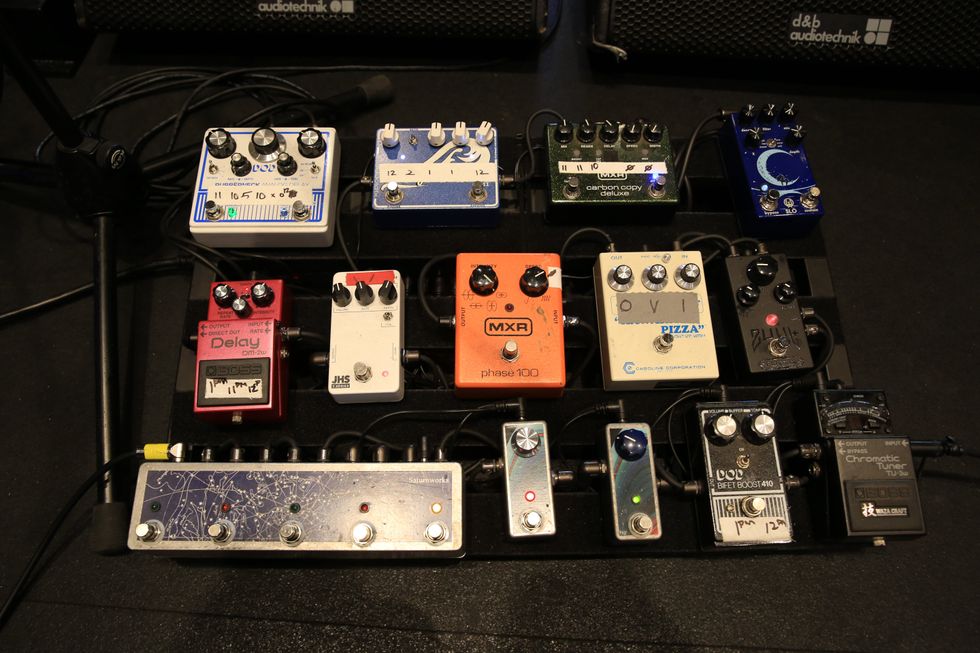
Primack’s board sports a Saturnworks True Bypass Multi Looper, plus two Saturnworks boost pedals. The rest includes a Boss TU-3w, DOD Bifet Boost 410, Caroline Electronics Hawaiian Pizza, Fortin ZUUL +, MXR Phase 100, JHS Series 3 Tremolo, Boss DM-2w, DOD Rubberneck, MXR Carbon Copy Deluxe, Walrus Slo, and SolidGoldFX Surf Rider III.
Taver’s Teles
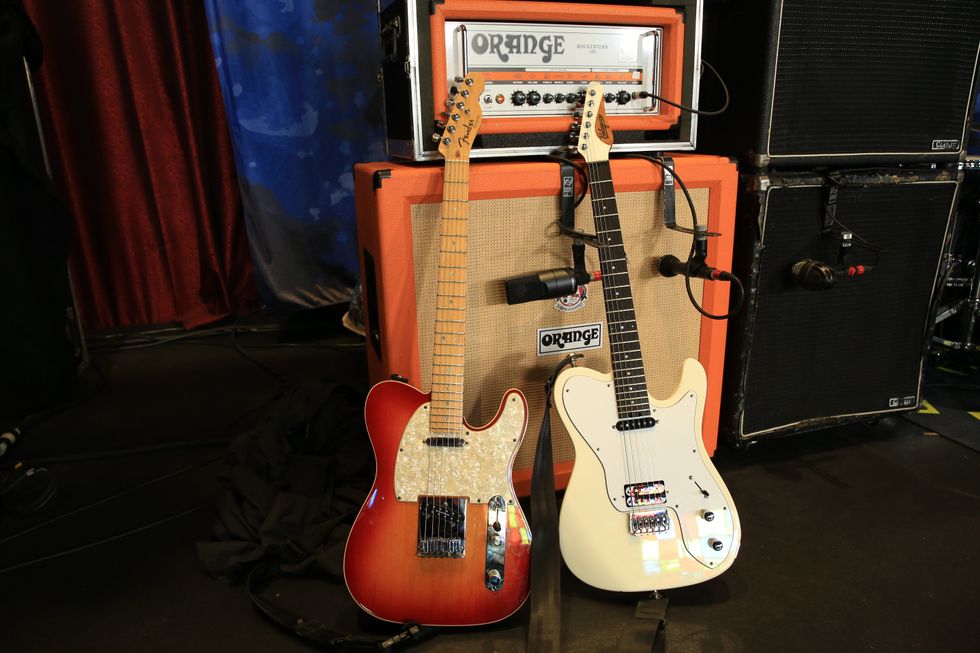
Vadim Taver’s go-to is this cherryburst Fender Telecaster, which he scored in the early 2000s and has been upgraded to Seymour Duncan pickups on Primack’s recommendation. His white Balaguer T-style has been treated to the same upgrade. The Balaguer is tuned to drop C, and the Fender stays in D standard. Both have D’Addario strings, with a slightly heavier gauge on the Balaguer.
Dual-Channel Chugger
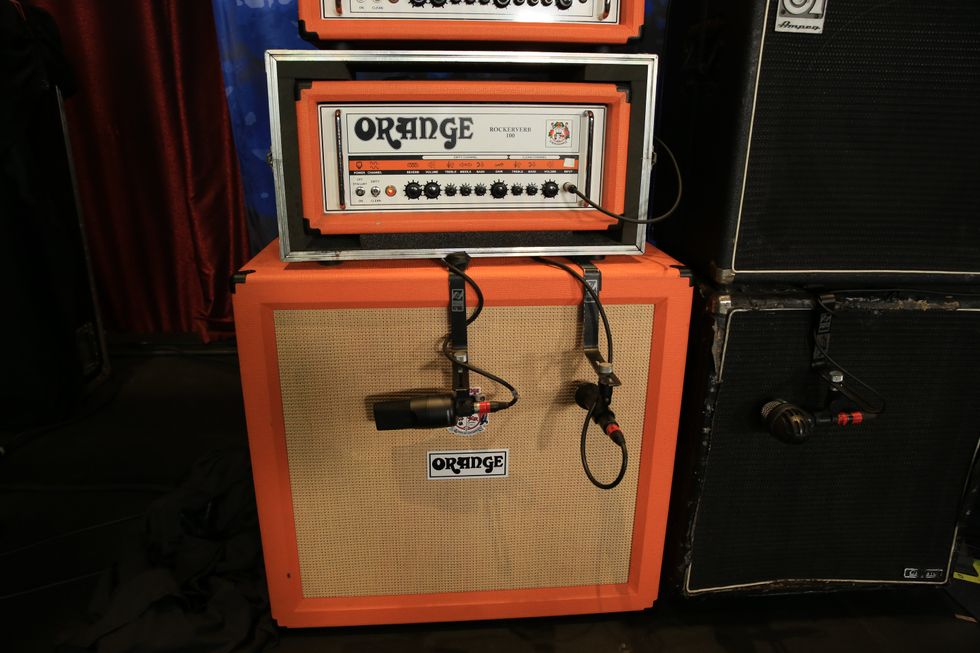
Taver loves his 2-channel Orange Rockerverb 100s, one of which lives in a case made right in Nashville.
Vadim Taver’s Pedalboard
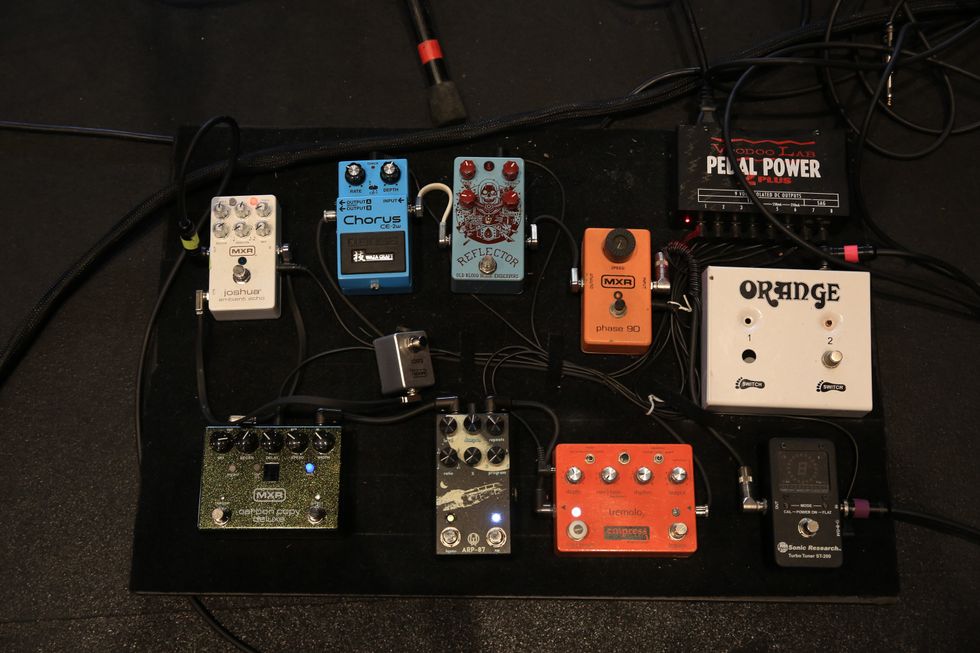
Taver’s board includes an MXR Joshua, MXR Carbon Copy Deluxe, Empress Tremolo, Walrus ARP-87, Old Blood Noise Endeavors Reflector, MXR Phase 90, Boss CE-2w, and Sonic Research Turbo Tuner ST-200, all powered by a Voodoo Lab Pedal Power 2 Plus.
Big Duff
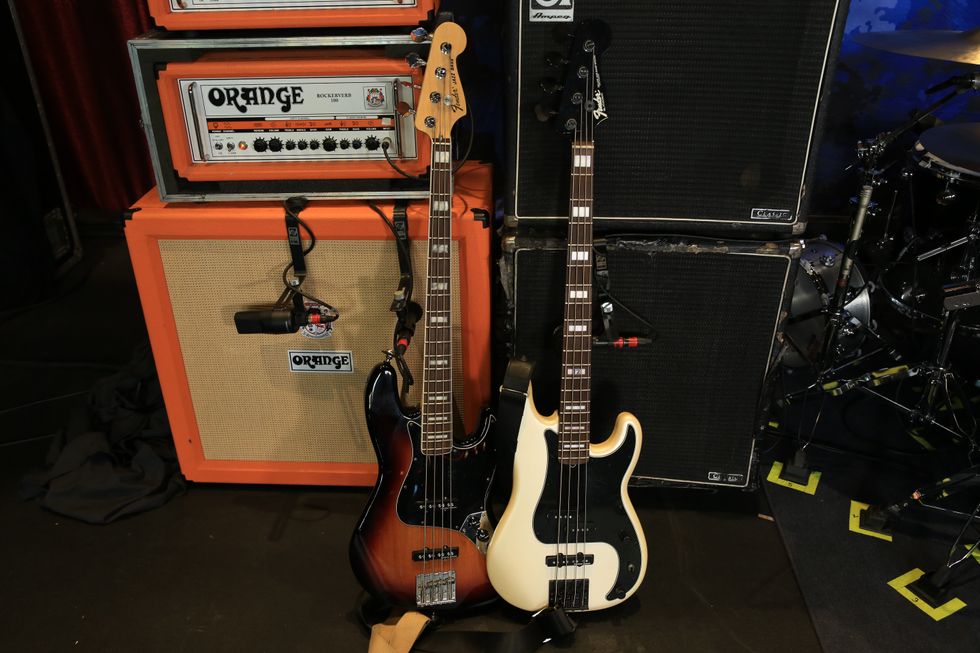
Harmon’s favorite these days is this Fender Duff McKagan Deluxe Precision Bass, which he’s outfitted with a Leo Quan Badass bridge. His backup is a Mexico-made Fender Classic Series ’70s Jazz Bass. This one also sports Primack-picked pickups.
Rental Rockers
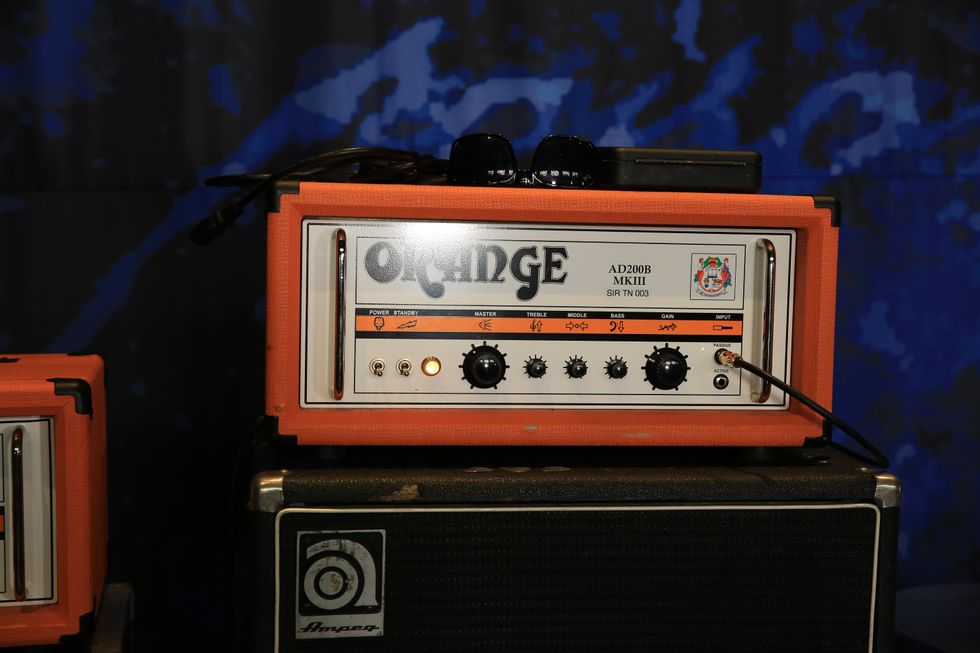
Harmon rented this Orange AD200B MK III head, which runs through a 1x15 cab on top and a 4x10 on the bottom.
Noah Harmon’s Pedalboard
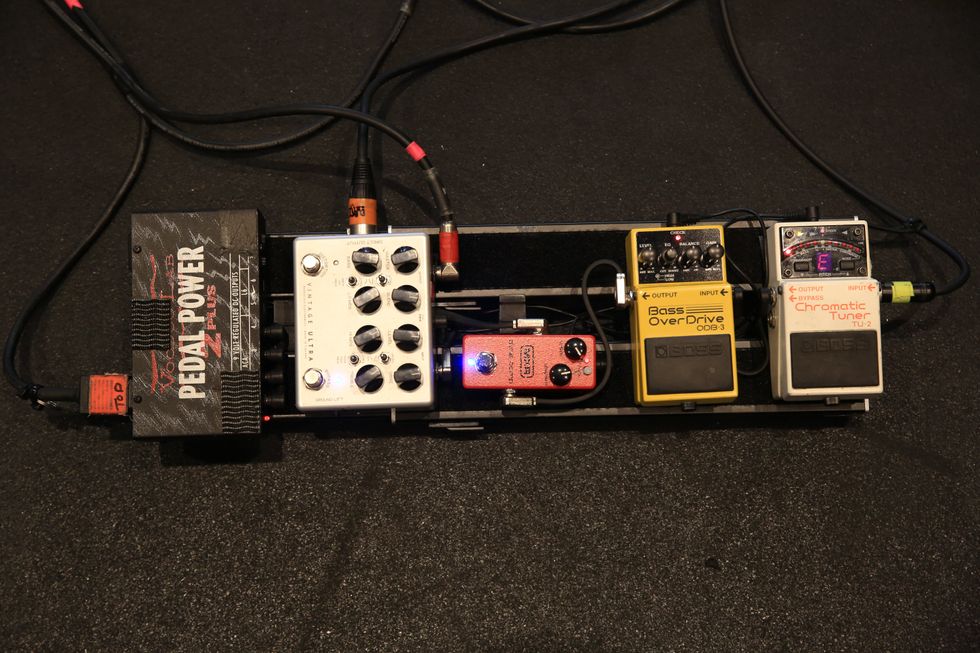
Harmon’s board carries a Boss TU-2, Boss ODB-3, MXR Dyna Comp, Darkglass Electronics Vintage Ultra, and a Voodoo Lab Pedal Power 2 Plus. His signal from the Vintage Ultra runs right to the front-of-house, and Harmon estimates that that signal accounts for about half of what people hear on any given night.

The Sunset is a fully analog, zero latency bass amplifier simulator. It features a ¼” input, XLR and ¼” outputs, gain and volume controls and extensive equalization. It’s intended to replace your bass amp both live and in the studio.
If you need a full sounding amp simulator with a lot of EQ, the Sunset is for you. It features a five band equalizer with Treble, Bass, Parametric Midrange (with frequency and level controls), Resonance (for ultra lows), and Presence (for ultra highs). All are carefully tuned for bass guitar. But don’t let that hold you back if you’re a keyboard player. Pianos and synthesizers sound great with the Sunset!
The Sunset includes Gain and master Volume controls which allow you to add compression and classic tube amp growl. It has both ¼” phone and balanced XLR outputs - which lets you use it as a high quality active direct box. Finally, the Sunset features zero latency all analog circuitry – important for the instrument most responsible for the band’s groove.
Introducing the Sunset Bass Amp Simulator
- Zero Latency bass amp simulator.
- Go direct into the PA or DAW.
- Five Band EQ:
- Treble and Bass controls.
- Parametric midrange with level and frequency controls.
- Presence control for extreme highs.
- Resonance control for extreme lows.
- Gain control to add compression and harmonics.
- Master Volume.
- XLR and 1/4" outputs.
- Full bypass.
- 9VDC, 200mA.
Artwork by Aaron Cheney
MAP price: $210 USD ($299 CAD).
His credits include Miles Davis’ Jack Johnson and Herbie Mann—next to whom he performed in Questlove’s 2021 documentary, Summer of Soul—and his tunes have been covered by Santana and the Messthetics. But it’s as a bandleader and collaborator where Sharrock cut his wildest recordings. As groundbreaking as Sharrock’s music could be, his distorted tone and melodic tunes helped bring rock listeners into the jazz tent. Our callers let us know how much Sharrock meant to them and why he’s one of the “top guys of all time.”
Belltone Guitars has partnered Brickhouse Toneworks to create a one-of-a-kind, truly noiseless Strat/Tele-tone pickup in a standard Filter’Tron size format: the Single-Bell pickup.
The Single-Bell by Brickhouse Toneworks delivers bonafide single-coil Strat and Tele tones with the power of a P-90 and no 60-cycle hum. Unlike typical stacked hum-cancelling designs, Brickhouse Toneworks uses a proprietary ‘sidewind’ approach that cancels the 60-cycle hum without sacrificing any of the dynamics or top-end sparkle of a Fender-style single coil.
Get the best of both worlds with clear bell-like tones on the neck pickup, signature quack when combining the neck and bridge pickups, and pristine twang in the bridge position backed with the fullness and power of a P-90. Push these into overdrive and experience the hallmark blues tone with plenty of grit and harmonic sustain — all with completely noiseless performance.
Key Features of the Single-Bell:
- Cast Alnico 5 Magnet, designed to be used with 500k pots
- Voiced to capture that signature Fender-style single coil tone without the 60-cycle hum
- Lightly potted to minimize squeal
- Made in the USA with premium quality materials
The retail price for a Bridge and Neck matching set is $340.00 and they’re available directly and exclusively through Belltone® Guitars / Brickhouse Toneworks at belltoneguitars.com.
